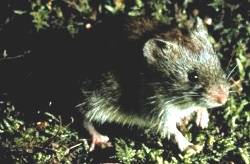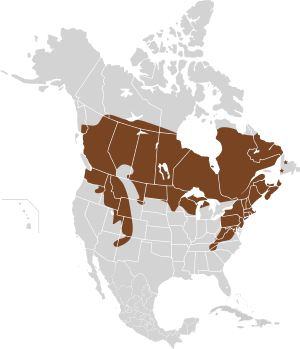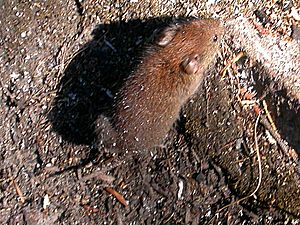Southern red-backed vole facts for kids
Quick facts for kids Southern red-backed vole |
|
|---|---|
 |
|
| Conservation status | |
| Scientific classification | |
| Genus: |
Myodes
|
| Species: |
gapperi
|
 |
|
The southern red-backed vole (Myodes gapperi), also known as Gapper's red-backed vole, is a small rodent. It has a slender body and can be found in Canada and the northern United States. This vole is related to the western red-backed vole, which lives further south and west. The western red-backed vole has less red fur and a tail that isn't as clearly two-colored.
Contents
What Does the Vole Look Like?
These voles are small and slender. They have a reddish stripe along their back. Their sides and head are grey, and their belly is lighter. In some parts of their range, especially in the northeast, they can be completely grey.
Size and Weight
Southern red-backed voles are about 12 to 16.5 centimeters (5 to 6.5 inches) long. Their tail is about 4 centimeters (1.5 inches) long. They usually weigh between 6 and 42 grams (0.21 to 1.48 ounces). The average weight is about 20.6 grams (0.72 ounces).
Daily Life and Habits
These voles are active all year round. They are mostly busy at night. They often use burrows that other small animals, like squirrels or groundhogs, have already dug.
Where Do Red-Backed Voles Live?

You can find these animals in different types of forests. This includes coniferous forests (with trees like pines), deciduous forests (with trees that lose their leaves), and mixed forests. They often live near wet areas like swamps or marshes.
How They Move Around
In warm weather, voles use small paths or "runways" through plants on the ground. When winter comes and snow falls, they dig tunnels under the snow. This helps them move around safely and stay warm.
What Do Voles Eat?
Southern red-backed voles are omnivores, meaning they eat both plants and animals. They munch on green plants, underground fungi, seeds, nuts, and roots. They also eat insects, snails, and berries. They are smart and store roots, bulbs, and nuts to eat later, especially when food is scarce.
Who Hunts the Vole?
Many animals hunt southern red-backed voles. Their main predators include hawks, owls, and mustelids (like weasels and minks).
Reproduction and Life Cycle
Female voles can have several litters of babies each year. They usually have two to four litters. Each litter can have between two and eight young voles.
See also
 In Spanish: Myodes gapperi para niños
In Spanish: Myodes gapperi para niños


